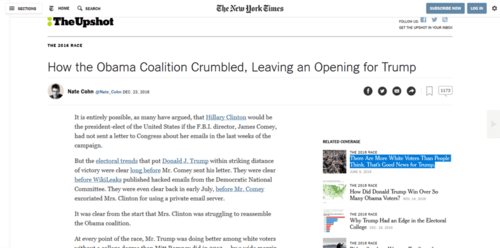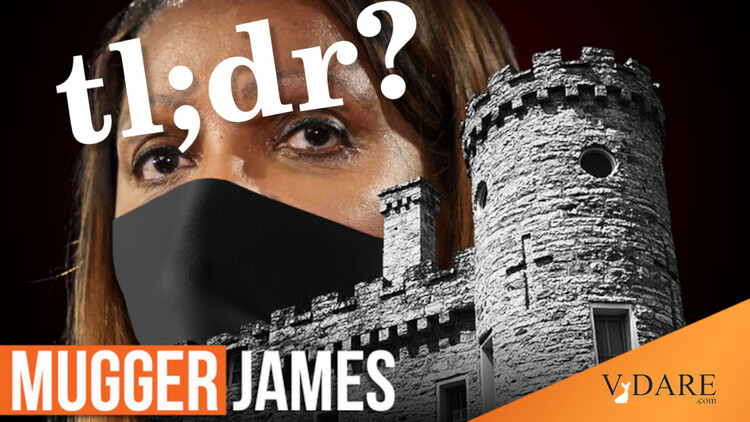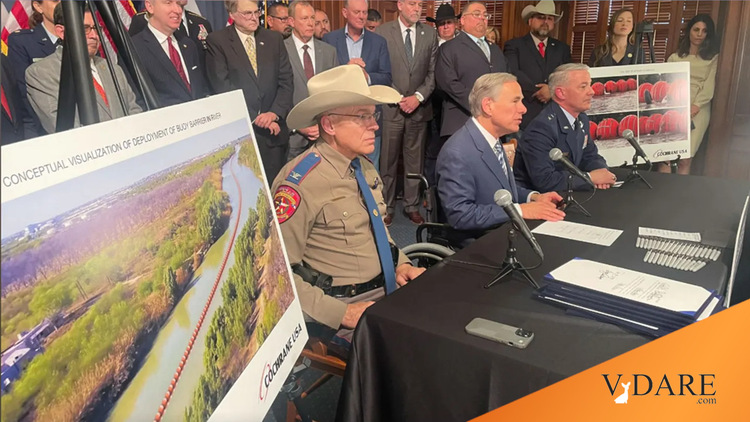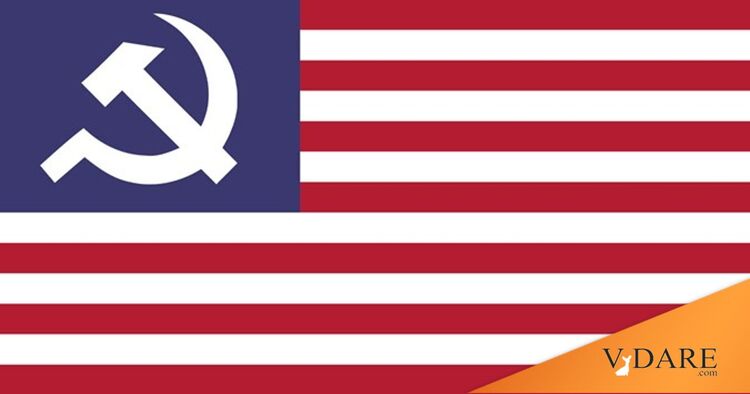Back on November 6, 2012, I blogged
Regional: Romney lost Electoral College in Great Lakes / North CentralToday, the other psephological Nate, Nate Cohn in the New York Times, has a long analysis of how Trump won in 2016 that’s basically the inverse of my 2012 analysis of how Romney lost:Romney lost by moderate margins in Iowa, Minnesota, Wisconsin, Michigan, Ohio, and Pennsylvania. Among Great Lakes States, he won Indiana and lost by a lot in Illinois.
Hispanics and Asians aren’t all that important in this swing region: in terms of voters, it’s basically pre-1965 white and black America. And Romney just didn’t appeal enough on manufacturing and jobs in that part of the country. How does the 2009 Auto Bailout sound as the key to the Electoral College in 2012?
How the Obama Coalition Crumbled, Leaving an Opening for Trump Nate Cohn @Nate_Cohn DEC. 23, 2016Yup. The G.M. and Chrysler Bailouts had to be the most old-fashioned issue of the 2012 campaign, and yet it looks to have been crucial in the Electoral College. Of course, the GOP Brain Trust immediately decided that Comprehensive Immigration Reform was the key to victory in 2016 …… At every point of the race, Mr. Trump was doing better among white voters without a college degree than Mitt Romney did in 2012 — by a wide margin. Mrs. Clinton was also not matching Mr. Obama’s support among black voters.
This was the core of the Obama coalition: an alliance between black voters and Northern white voters, from Mr. Obama’s first win in the 2008 Iowa caucuses to his final sprint across the so-called Midwestern Firewall states where he staked his 2012 re-election bid.
In 2016, the Obama coalition crumbled and so did the Midwestern Firewall. …
Campaign lore has it that President Obama won thanks to a young, diverse, well-educated and metropolitan “coalition of the ascendant” — an emerging Democratic majority anchored in the new economy. Hispanic voters, in particular, were credited with Mr. Obama’s victory.
But Mr. Obama would have won re-election even if he hadn’t won the Hispanic vote at all. He would have won even if the electorate had been as old and as white as it had been in 2004.
Largely overlooked, his key support often came in the places where you would least expect it. He did better than John Kerry and Al Gore among white voters across the Northern United States, despite exit poll results to the contrary. Over all, 34 percent of Mr. Obama’s voters were whites without a college degree — larger in number than black voters, Hispanic voters or well-educated whites.
[Obama in 2012] excelled in a nearly continuous swath from the Pacific Coast of Oregon and Washington to the Red River Valley in Minnesota, along the Great Lakes to the coast of Maine. In these places, Mr. Obama often ran as strong or stronger than any Democrat in history.
In 2016, Mr. Trump made huge gains among white working-class voters. It wasn’t just in the places where Democratic strength had been eroding for a long time, like western Pennsylvania. It was often in the places where Democrats had seemed resilient or even strong, like Scranton, Pa., and eastern Iowa.
It was a decisive break from recent trends. White voters without college degrees, for the first time, deviated from the national trend and swung decidedly toward the Republicans. No bastion of white, working-class Democratic strength was immune to the trend.
For the first time in the history of the two parties, the Republican candidate did better among low-income whites than among affluent whites, according to exit poll data and a compilation of New York Times/CBS News surveys.
According to exit polls, Mr. Trump did better than Mr. Romney by 24 points among white voters without a degree making less than $30,000 a year. He won these voters by a margin of 62 to 30 percent, compared with Mr. Romney’s narrow win of 52 percent to 45 percent.
In general, exit poll data should be interpreted with caution — but pre-election polls show a similar swing, and the magnitude of the shifts most likely withstands any failings of the exit polls.
Mrs. Clinton’s profound weakness among Northern white working-class voters was not expected as recently as six months ago. She was thought to be fairly strong among the older white working-class voters who were skeptical of Mr. Obama from the start. Most of Mr. Obama’s strength among white voters without a degree was due to his gains among those under age 45.
But Mr. Trump expanded on Republican gains among older working-class white voters, according to Upshot estimates, while erasing most of Mr. Obama’s gains among younger Northern white voters without a degree. …
His gains among younger working-class whites were especially important in the Upper Midwest. Young white working-class voters represent a larger share of the vote there than anywhere else in the country. …
The exit polls also show all of the signs that Mr. Trump was winning over Obama voters. Perhaps most strikingly, Mr. Trump won 19 percent of white voters without a degree who approved of Mr. Obama’s performance, including 8 percent of those who “strongly” approved of Mr. Obama’s performance and 10 percent of white working-class voters who wanted to continue Mr. Obama’s policies.
Mr. Trump won 20 percent of self-identified liberal white working-class voters, according to the exit polls, and 38 percent of those who wanted policies that were more liberal than Mr. Obama’s.
It strongly suggests that Mr. Trump won over large numbers of white, working-class voters who supported Mr. Obama four years earlier.
The notion that Mr. Trump could win over so many people who voted for Mr. Obama and who still approved of his performance is hard to understand for people with ideologically consistent views on a traditional liberal-conservative spectrum. Mr. Trump, if anything, was Mr. Obama’s opposite.
But the two had the same winning pitch to white working-class voters.
Mr. Obama and his campaign team portrayed Mr. Romney as a plutocrat who dismantled companies and outsourced jobs. The implication was that he would leave middle-class jobs prey to globalization and corporations.
The proof of Mr. Obama’s commitment to the working class and Mr. Romney’s callousness, according to the Obama campaign, was the auto bailout: Mr. Obama protected the auto industry; Mr. Romney wrote “Let Detroit Go Bankrupt” in The New York Times.
There was one place where Mr. Romney was able to effectively argue that he could protect the industrial economy and the people who worked in it: coal country. There he made big gains after the Obama administration pushed climate-change policies that would reduce the production and use of coal. …I’ve been saying that since 2000.Taken together, Mr. Trump’s views on immigration, trade, China, crime, guns and Islam all had considerable appeal to white working-class Democratic voters, according to Pew Research data. It was a far more appealing message than old Republican messages about abortion, same-sex marriage and the social safety net. …
Taken in totality, it appears that black turnout dropped somewhere between 5 percent and 10 percent — with few exceptions. It should be noted that the decline in black turnout appears very consistent across the country, regardless of whether states put in new laws that might reduce turnout, like those cutting early voting or requiring a photo ID.
Was the decline in black turnout enough to change the result of the election? It seems so. If black turnout had matched 2012 levels, Mrs. Clinton would have almost certainly scratched out wins in Wisconsin, Michigan and Pennsylvania. Florida and North Carolina would have been extremely close.
But pinning Mrs. Clinton’s loss on low black turnout would probably be a mistake. Mr. Obama would have easily won both his elections with this level of black turnout and support. (He would have won Michigan, Ohio and Wisconsin each time even if Detroit, Cleveland and Milwaukee had been severed from their states and cast adrift into the Great Lakes.) …
The Clinton campaign believed it could compensate for the loss of the Obama coalition by winning the so-called “rising American electorate” or “coalition of the ascendant” of well-educated voters and Hispanic voters — a caricature of the Obama coalition.
These demographic shifts have benefited Democrats over the last decade, but most of these gains have come in noncompetitive states.











